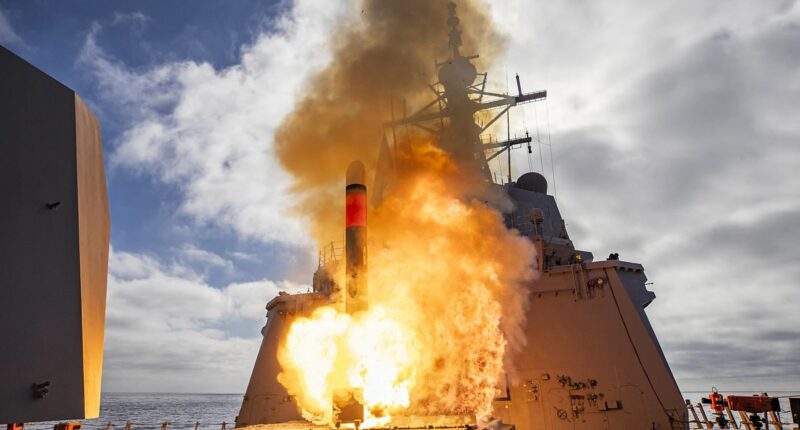Share this @internewscast.com
The United States risks triggering a major response from Vladimir Putin by supplying Ukraine with intelligence on long-range energy infrastructure targets inside Russia, two officials confirmed on Wednesday.
The move, first reported by the Wall Street Journal, comes as Washington weighs whether to send Kyiv missiles that could be used in such strikes and is urging NATO allies to provide similar support.
It also comes just days after the Kremlin reacted furiously to reports that Donald Trump was considering deploying Tomahawk missiles requested by President Zelensky, raising fears of further escalation.
Officials said the decision marks the first major policy change Trump has signed off on since hardening his rhetoric toward Russia, as he seeks to bring an end to Moscow’s war in Ukraine, now entering its fourth year.
Washington has long been sharing intelligence with Kyiv, but the Wall Street Journal said it will now be easier for Ukraine to hit infrastructure like refineries, pipelines, and power plants with the aim of depriving the Kremlin of revenue and oil.
Trump has been pressing European countries to stop buying Russian oil in exchange for his agreement to impose tough sanctions on Moscow in a bid to try to dry up funding for Russia’s invasion of Ukraine.
Neither the White House nor Ukraine’s mission to the United Nations immediately responded to separate requests for comment. Russia’s U.N. mission in New York declined to comment.

The Kremlin reacted furiously to reports that Donald Trump was considering deploying Tomahawk missiles requested by President Zelensky, raising fears of further escalation. Pictured: The HMAS Brisbane firing a Tomahawk Weapon System off the west coast of the US

Officials said the decision marks the first major policy change Trump has signed off on since hardening his rhetoric toward Russia, as he seeks to bring an end to Moscow ’s war in Ukraine, now entering its fourth year

Pictured: Firefighters extinguish a fire at Barabashovo market after Russian aerial attack on October 1, 2025 in Kharkiv, Ukraine
According to U.S. officials, the approval for additional intelligence came shortly before Trump posted on social media last week suggesting that Ukraine could retake all its land occupied by Russia, in a striking rhetorical shift in Kyiv’s favor.
‘After seeing the Economic trouble (the war) is causing Russia, I think Ukraine, with the support of the European Union, is in a position to fight and WIN all of Ukraine back in its original form,’ Trump wrote on Truth Social last Tuesday, shortly after meeting Ukrainian President Volodymyr Zelenskiy.
That rhetoric coincided with Ukraine’s push to obtain Tomahawk missiles, which have a range of 2,500 km (1,550 miles) and are able to hit Moscow and most of European Russia if fired from Ukraine.
Ukraine has also developed its own long-range missile named the Flamingo, but quantities are unknown as the missile is in early production.
In a Fox news interview last week Keith Kellogg, America’s special envoy to Ukraine, said that Trump has indicated that Kyiv should now be able to conduct long-range strikes on Russia.
Meanwhile, Vice President JD Vance told the broadcaster that Trump would make the final call on whether to allow a deal that would give both European allies and Ukraine permission to purchase Tomahawks.

Vice President JD Vance told the broadcaster that Trump would make the final call on whether to allow a deal that would give both European allies and Ukraine permission to purchase Tomahawks

Apartment building damaged by Russian military strike, amid Russia’s attack on Ukraine, in the frontline town of Kostiantynivka in Donetsk region, Ukraine September 29, 2025
Following the interviews, Russia said that it would carefully analyse whether any American Tomahawk missiles that might be supplied to Ukraine were fired using targeting data supplied by the United States.
Kremlin spokesman Dmitry Peskov said: ‘The question, as before, is this: who can launch these missiles…? Can only Ukrainians launch them, or do American soldiers have to do that?’
‘Who is determining the targeting of these missiles? The American side or the Ukrainians themselves?’ Peskov added, saying ‘a very in-depth analysis’ was required.
In any case, he said, Tomahawks would not be a game-changer.
‘Even if this happens, there’s no panacea that can change the situation on the front for the Kyiv regime right now. There’s no magic weapon. And whether it’s Tomahawks or other missiles, they won’t be able to change the dynamic,’ Peskov said.
Russia launched its full-scale invasion of Ukraine in February 2022, calling it a ‘special military operation’ to halt Kyiv’s Westward geopolitical drift and what it considers to be a dangerous NATO expansion to the east.
Kyiv and European allies consider the invasion to be an imperial-style land grab.
Trump began his second term as president in January, vowing to quickly end the war in Ukraine.
‘President Trump is a special kind of politician. He likes quick fixes and this is a situation where quick fixes do not work,’ Russia’s U.N. Ambassador Vassily Nebenzia said earlier on Wednesday during a press conference to mark the start of Russia’s October presidency of the U.N. Security Council.
Nebenzia also cited Russian Foreign Minister Sergei Lavrov as saying that if the U.S. decided to supply Ukraine with tomahawks ‘it will not change the situation on the battlefield.’
This is the first time the United States will provide assistance with Ukrainian long-range strikes deep into Russian territory on energy targets, officials told the Wall Street Journal.
Energy revenue remains the Kremlin’s single most important source of cash to finance the war effort, making oil and gas exports a central target of Western sanctions.
Trump has taken steps to impose an additional tariff on imports from India to pressure New Delhi to halt its purchases of discounted Russian crude oil, and lobbied the likes of Turkey to stop buying oil from Moscow too.
Earlier on Wednesday, the Group of Seven nations’ finance ministers said they will take joint steps to increase pressure on Russia by targeting those who are continuing to increase their purchases of Russian oil and those that are facilitating circumvention.





